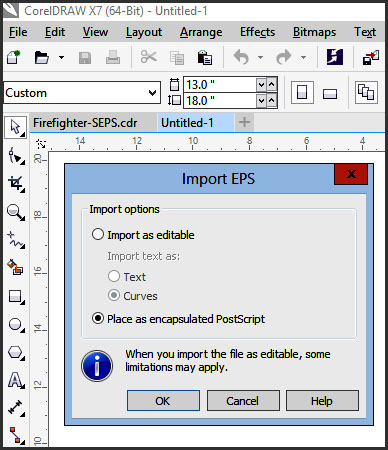
Next, click the 2 black arrows beside the Print Preview button in the bottom left corner. Normally you need a postscript output device selected to be able to see all these options.

This choice will show us all the options for printing separations. For tutorial purposes, I am choosing DEVICE INDEPENDENT POSTSCRIPT FILE. The next very helpful tool for printing separations is inside the actual print window. With this setting on, you are less likely to waste films, screens or paper. Click the checkbox for Print only current page and click OK. Go to Tools > Options > Global and select Printing in the left column. So, to make sure we only print from the active page you can modify a setting inside the CorelDRAW options. When printing separations only the active page is usually being printed. For extra organization in your file, you can label the page the color being printed by right-clicking on the name of the page. For the white ink base, you would print it from this page. For example, page 2 in the exercise file has the base white separation. You can use another page for these modified versions of the artwork.

Sometimes screen-printed separations need trapping or a base color for printing.
#Color separation in coreldraw x7 registration
If you drag the registration mark to your document palette or a custom palette, it will add the color to your palette to have it easily available whenever you need. If you click the drop-down arrow in this window and look at the bottom of the list, you will see the registration color. Select a registration mark, then double-click the Outline settings in the bottom right of the interface. You can drag this color to the document palette or a custom palette for easy access. This color is good for job names and registration marks to keep them consistent on all films or screens. If you use the registration color for these marks it will show up on each separation without having to change the color. When printing screen-printed separations, you can add your own custom registration marks on the page so you can control where they are on the output. They are labeled with a name, so you know exactly which separation or color plate you are printing. Think of it like a coloring book and each color crayon you color with or use from the spot color palette is a separation. In some printing processes that use spots color, like screen printing, you need to isolate each color into individual color areas so they can be printed on the same plate or screen.
#Color separation in coreldraw x7 how to
You will learn how to manage some of the settings inside CorelDRAW that will help you feel confident that when you hit “print” you will get exactly what you wanted in your output. Spot colours are commonly used in corporate logos and identity programs, and in one, two or three-colour jobs.In this tutorial you will learn about printing color separations. Also created without screens, PANTONE metallic and pastel colours are considered part of the PANTONE MATCHING SYSTEM.ĭue to the gamut of the 14 basic colours, some spot colours will be cleaner and brighter than if they were created in the four-colour process described below. The letter suffix refers to the paper stock on which it is printed: C for Coated paper, U for Uncoated paper and M for Matte paper. A PANTONE Chip supplied with the ink and/or job ensures that the printer achieves the colour desired by the customer.Įach colour in the System has a unique name or number followed by either a C, U or M. Printers can then order the colours by number or mix it themselves according to the ink mixing formula in a PANTONE formula guide. To retain their license, they must annually submit samples of the 14 basic colours for approval by Pantone. The precision begins with the printing ink manufacturers who are licensed by Pantone to manufacture inks for mixing PANTONE MATCHING SYSTEM colours. Creating a PANTONE Spot colour is similar in concept, but with the added need for precision. You probably mixed yellow and blue paint to get green in your youth. From a palette of 14 basic colours, each of the spot colours in the PANTONE MATCHING System is mixed according to its own unique ink mixing formula developed by Pantone. Spot VS Process Colour - Appreciate the DifferenceĬolours created without screens or dots, such as those found in the PANTONE MATCHING SYSTEM®, are referred to in the industry as spot or solid colours. Printed below is an extraxt from the official Pantone site maybe you would like to show it to your printer? I retired from the print industry 14 years ago and had used the PMS system many years before thet. If your printer is using modern technology he should have a Pantone Mixing guide, whereby he can match your colour whatever form it takes either RGB, CMYK or any other.


 0 kommentar(er)
0 kommentar(er)
